Economical and portable; are the two adjectives that can be used to describe circular saws best. These invaluable woodworking tools can be used to make all kinds of cuts. From long rip cuts to miter and even beveled cuts.
It is for this reason that no woodworker wants to be without one. However, it is worth noting that circular saws come in various subcategories, each with cons and pros. That being said, let’s take a closer look at the main types of circular saws available.
Overview Of 15 Types Of Circular Saws
1. Corded Circular Saws
All circular saws generally fall within two main categories, cordless and corded. Corded circular saws are electric-powered and have to be plugged into a power source using a power cord, hence the name. In most cases, corded circular saws offer more power than cordless saws.
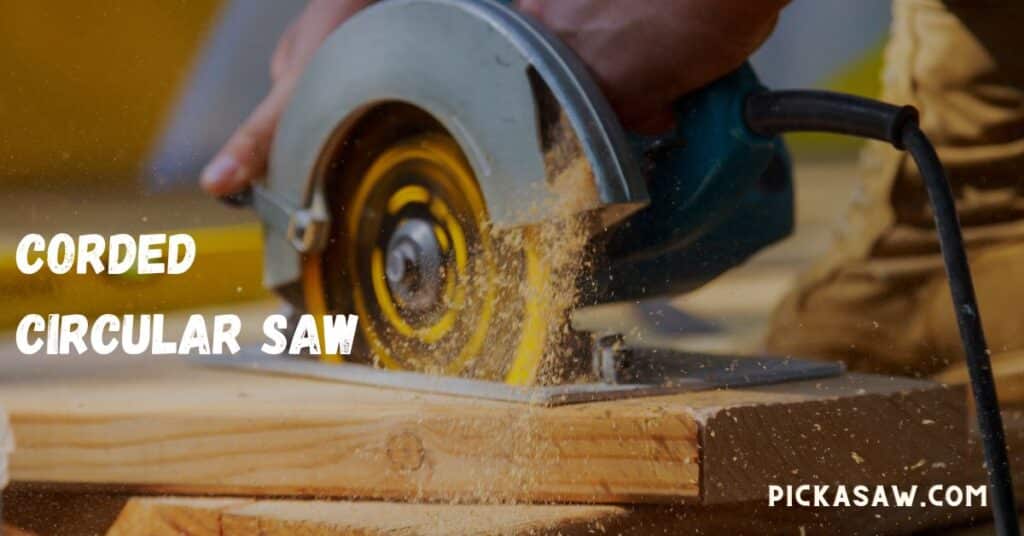
Features
- Power cord for connecting to a power source
- High blade RPM
- Magnesium shoe plate
Advantages Of Using Corded Circular Saws
- Corded circular saws tend to be more powerful than cordless models
- Most corded saws feature a 7.5-inch blade which is capable of cutting larger materials
- No need to purchase additional parts, such as a battery
Disadvantages Of Using Corded Circular Saws
They have limited portability and reach since they have to be used near an electric power source at all times.
Corded Circular Saw Ideal For?
Corded circular saws are ideal for heavy-duty cutting. Since they do not require a battery, they have a longer run time than cordless models. As such, they are suitable for contractors handling the cutting of many materials.
2. Cordless Circular Saws
Cordless circular saws, on the other hand, are powered by a rechargeable lithium-ion battery. This makes them popular for home use. They are usually portable and weigh less than their corded counterparts. Cordless circular saws are beginner friendly and tend to be smaller.
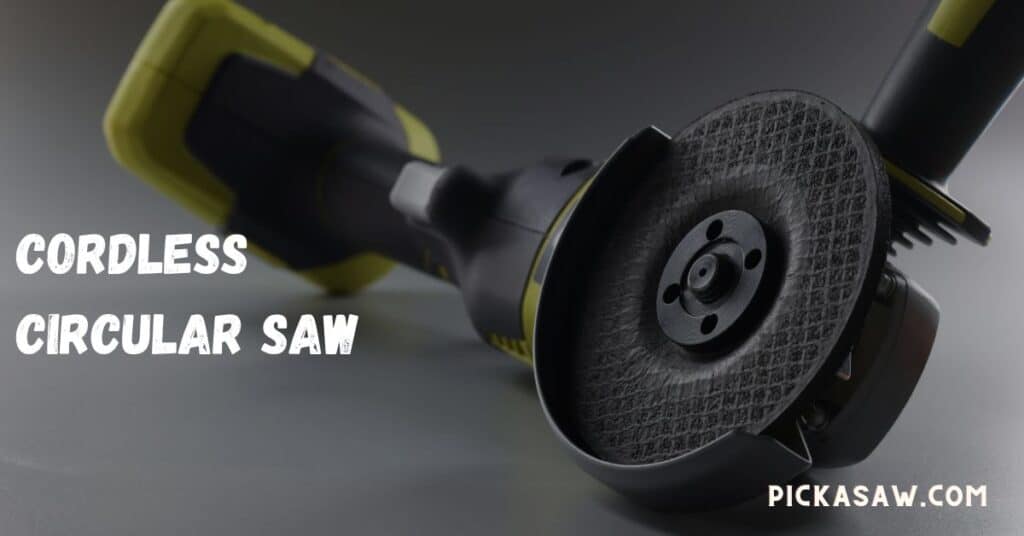
Features
- Lightweight construction
- Rechargeable lithium-ion battery
- Typically have smaller blades
Advantages Of Using Cordless Circular Saws
- Due to them being cordless, they are highly portable and can be used virtually anywhere
- Since they are small, they are ideal for cutting in tight places
- Given that they typically have smaller blades, they tend to be safer
Disadvantages Of Using Cordless Circular Saws
- The run time of cordless saws is limited to the battery power and thus can not run for long periods compared to corded models
Cordless Circular Saw Ideal For?
Since these saws are portable and smaller, these saws are suitable for DIYers as well as contractors working in areas where an electrical socket is not readily available.
3. Sidewinder Circular Saws
These circular saws come to many people’s minds when they think of circular saws. Sidewinder circular saws are perhaps the most popular. They feature a motor mounted on the left side of the blade. And tend to be more compact than other types of saws.
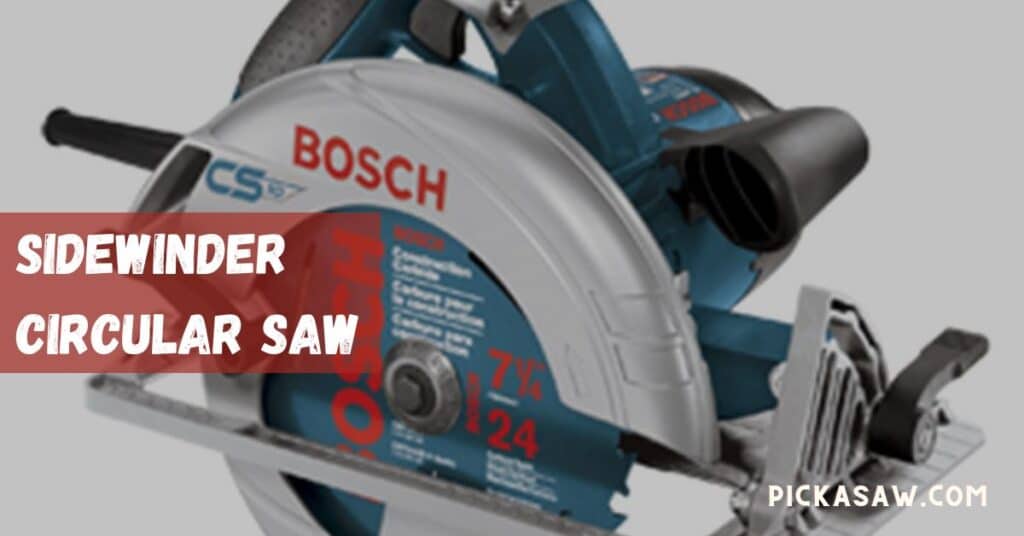
Features
- The motor mounted on the left side of the blade
- Typically have a higher blade RPM speed
- Gears placed at 90 degrees angle
Advantages Of Using Sidewinder Circular Saws
- Due to the position of the motor and blade, they are more energy-efficient
- These saws are usually more portable than other types
- Typically do not need oil changes
Disadvantages Of Using Sidewinder Circular Saws
- They generally produce less power than some other types of circular saws
Sidewinder Circular Saw Ideal For?
Sidewinder circular saws are ideal for making rip cuts and cutting soft lumber. They are also perfect for both vertical and overhead cuts.
4. Worm Drive Saws
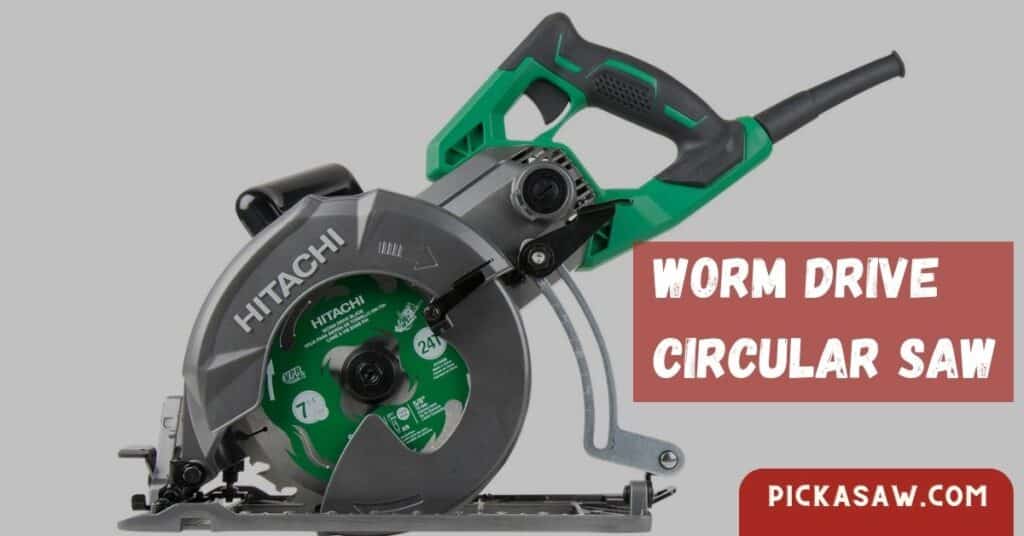
Unlike sidewinder saws, worm drive saws have the motor mounted behind the blade. This results in reduced blade speed but increased torque. Also, these saws tend to be thinner and deeper, which improves blade visibility when cutting.
Features
- Reduced RPM blade speed
- Increased torque
- The motor positioned at the back of the blade
Advantages Of Using Worm Drive Saws
- Offers more torque and thus increased power
- It is easier to see the blade when cutting
- Improved transfer of power
Disadvantages Of Using Worm Drive Saws
- These saws are usually heavier
Worm Drive Saw Ideal For?
These saws are ideal for making longer crosscuts as well as plunge cuts and miter cuts
5. Hypoid Circular Saw
It is common for people to mistake hypoid circular saws for worm drive saws. While the two saws are somewhat similar, they have some differences. Similar to worm drive saws, the motor of a hypoid saw is located behind the blade. However, unlike worm drive saws, they do not require oiling.
Features
- Closed gear system
- 90 degrees angle gear placement
- Increased torque but reduced blade speed
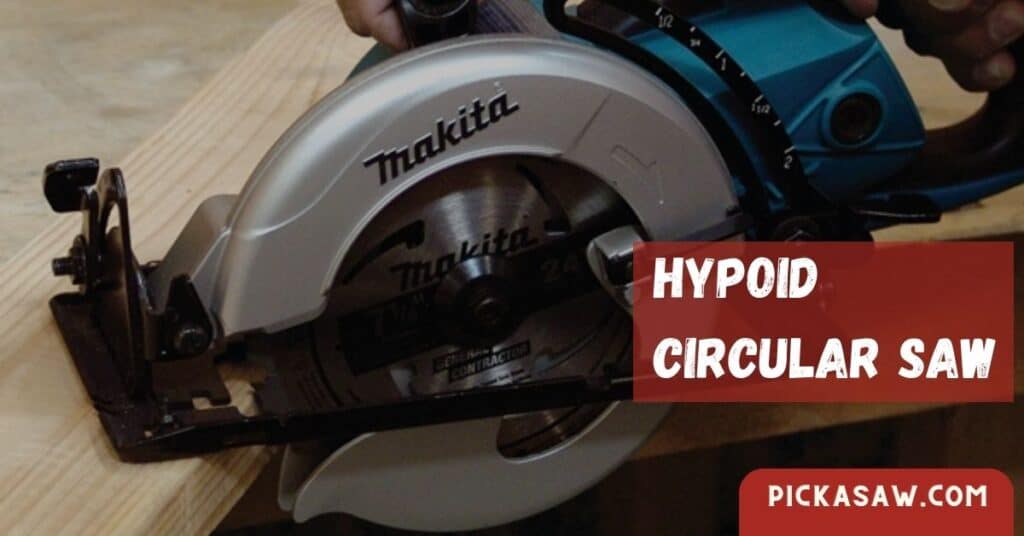
Advantages Of Using Hypoid Circular Saw
- Hypoid saws offer more power than sidewinder saws
- These saws do not need to be oiled, which makes maintenance easy
- These saws typically have a quieter operation than others
Disadvantages Of Using Hypoid Circular Saw
- Hypoid circular saws are typically heavier than others
Hypoid Circular Saw Is Ideal For?
Due to their increased torque, they are suitable for cutting hard or wet lumber. They are also suitable for heavy-duty tasks
6. Abrasive Circular Saws
The abrasive saws differ from other types of circular saws in that they feature a toothless blade. Instead, these saws use blades with a flat surface. Due to the unique blades, they are used to cut materials that are harder than wood.
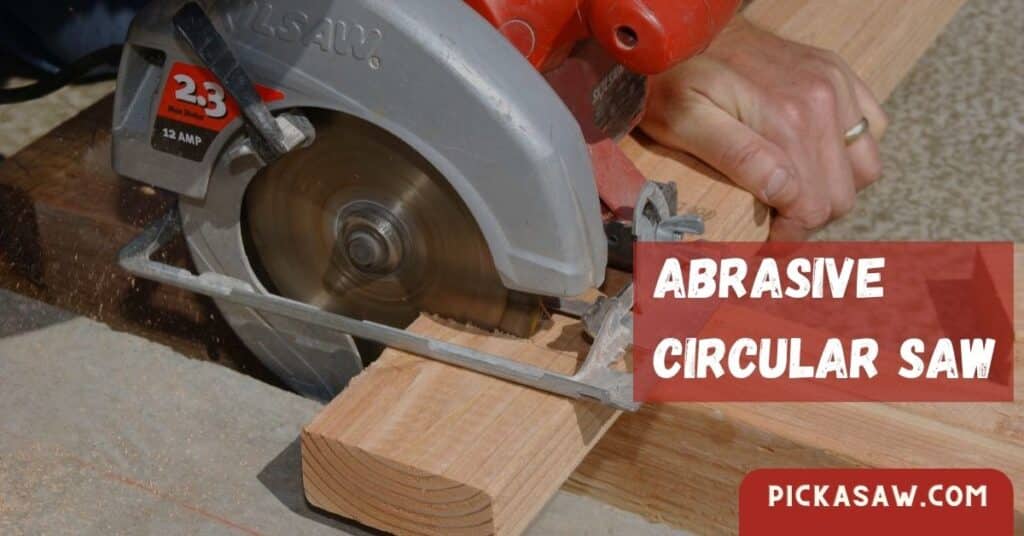
Features
- Flat toothless blade
- Diamond or cubic boron nitride blade edges
- Increased heat due to friction
Advantages Of Using Abrasive Circular Saws
- They offer great control
- Can cut through materials harder than wood
- They are available in different configurations
Disadvantages Of Using Abrasive Circular Saws
- The blades of these saws produce a lot of heat as a result of friction
Abrasive Circular Saw Is Ideal For?
As mentioned, these types of saws are used for cutting materials harder than wood. These include pipes, tiles, and metals.
7. Miter Saws
Miter saws can also be classified as circular saws however there is a fine line between circular and miter saws. They are basically circular saws attached to a radial arm. This attachment allows for the raising and lowering of the arm onto a cramped work area. They function much like paper cutters but for woodworkers.
Features
- A swinging radial arm
- Ability to make angled cuts
- Circular blade
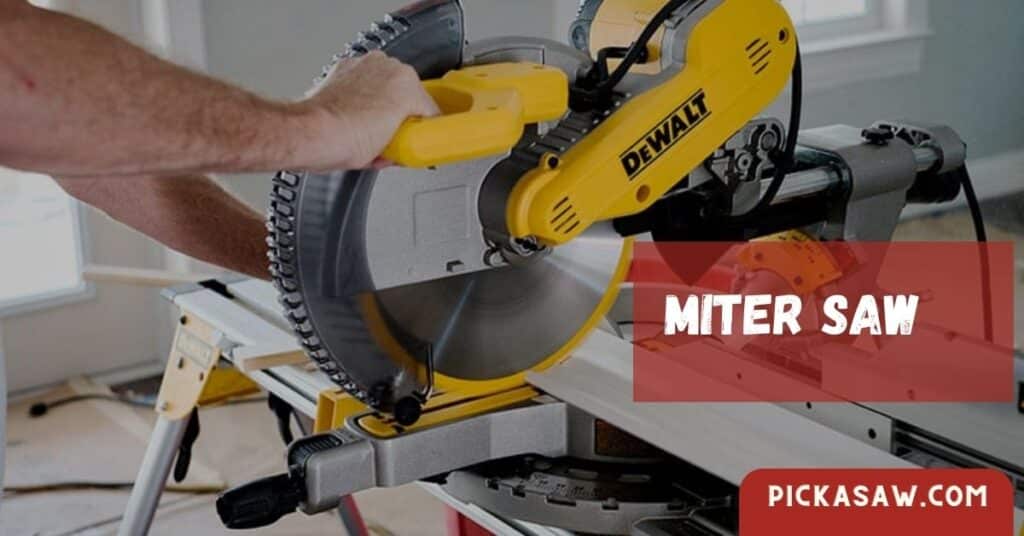
Advantages Of Using Miter Saws
- Miter saws can make many different types of cuts compared to a standard circular saw
- They are easier to use compared to other saws
- These saws are also safer to use
Disadvantages Of Using Miter Saws
- Miter saws tend to be more expensive compared to other types of circular saws
Miter Saw Is Ideal For?
These types of saws are suitable for cutting many pieces of lumber. They are also ideal for making bevel and angled cuts.
8. Brushcutter circular saw
A Brushcutter circular saw, also known as a brush blade or brushcutter blade, is a specialized attachment designed for use with brushcutters or clearing saws. It is used to cut through dense vegetation, woody plants, small trees, and tough brush that regular string trimmer lines cannot handle. Here are the features, advantages, disadvantages, uses, and other important facts about brushcutter circular saws:
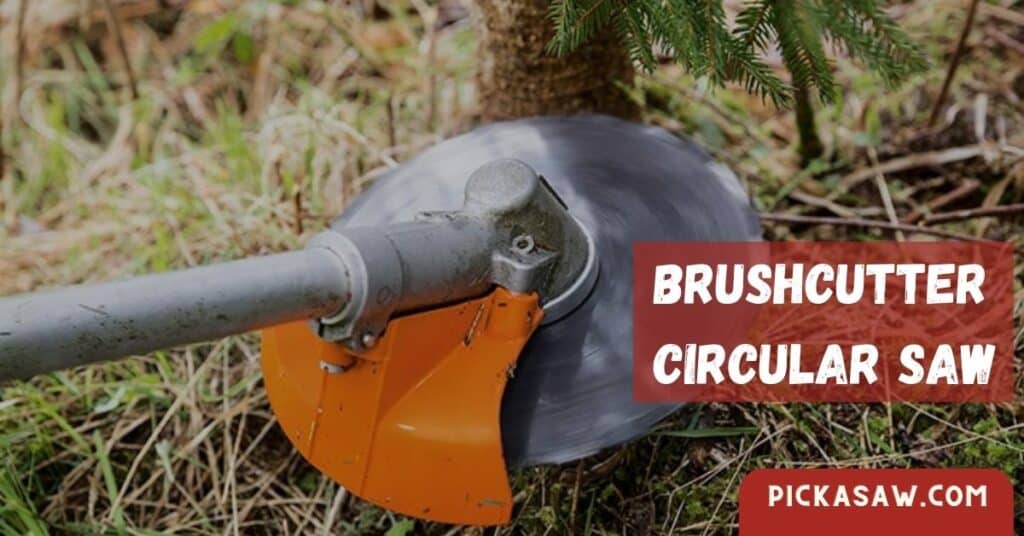
Features:
- Blade Design: Brushcutter circular saws typically feature a circular blade with large, sharp teeth designed to cut through thick vegetation efficiently.
- Blade Diameter: The blade diameter can vary, but it is generally larger than the cutting heads of regular string trimmers to handle heavier tasks.
- Material: These blades are usually made of durable materials like hardened steel or carbide, which allows them to withstand the rigors of cutting through tough vegetation.
Advantages:
- Cutting Power: Brushcutter circular saws provide significantly more cutting power compared to string trimmers. They can easily handle thick grass, weeds, shrubs, and small trees.
- Efficiency: Due to their larger blades and powerful motors, these tools allow for faster and more efficient clearing of large areas with dense vegetation.
- Versatility: Brushcutter circular saws can be used for a variety of applications, including land clearing, trail maintenance, fence-line trimming, brush removal, and more.
- Ease of Use: They are relatively easy to use, as they can be attached to compatible brushcutters or clearing saws with the appropriate adapter.
Disadvantages:
- Weight and Bulk: The added cutting power and larger blades make brushcutter circular saws heavier and bulkier compared to standard string trimmer attachments.
- Safety Considerations: The powerful cutting action of these blades demands caution during operation. Proper safety equipment, such as eye protection, gloves, and sturdy footwear, should be worn to minimize the risk of injury.
Uses:
- Land Clearing: Brushcutter circular saws are commonly used for clearing overgrown areas, such as fields, meadows, and abandoned lots.
- Vegetation Management: They are useful for maintaining trails, clearing paths in the wilderness, or removing unwanted vegetation around structures.
- Forestry and Agriculture: These tools are employed in forestry operations to clear brush and small trees and in agricultural settings to manage crop perimeters and remove unwanted vegetation.
Important Facts:
- Maintenance: It is crucial to keep the blade sharp and periodically inspect it for damage to ensure optimal performance.
- Compatibility: Brushcutter circular saws are designed to be compatible with specific models of brushcutters or clearing saws. It is essential to choose a blade that is compatible with your specific equipment.
- Operator Skill: Operating a brushcutter circular saw requires some skill and experience. It’s important to read and follow the manufacturer’s instructions and guidelines for safe and efficient use.
9. Concrete Circular Saws/ Grinders
Also known as concrete circular saws, grinders are used for the same function as abrasive circular saws. But unlike their abrasive counterparts, they feature a different kind of blade. The teeth on these saws are made from industrial diamonds and are designed for cutting materials harder than wood.
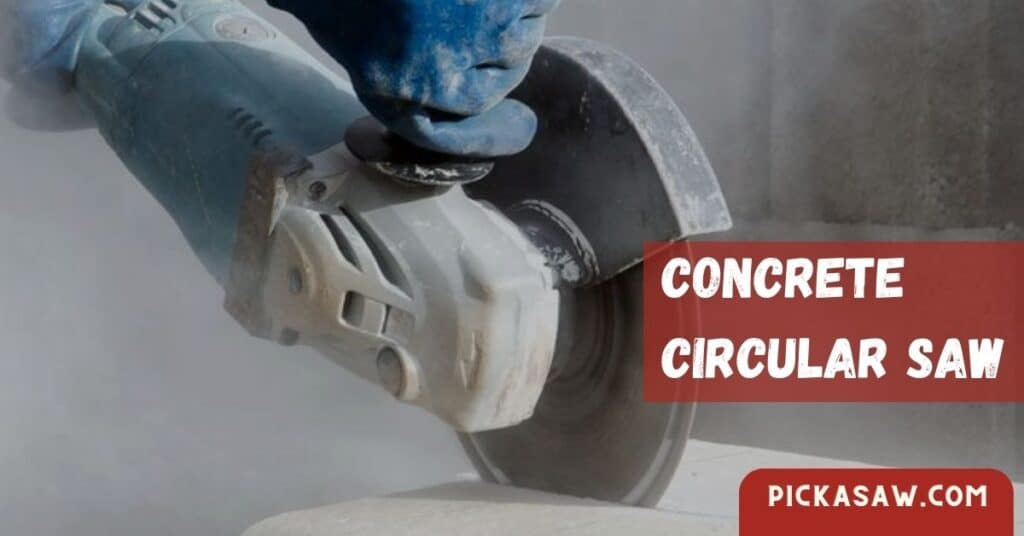
Features
- Industrial diamond-tipped teeth
- Larger blades
- Bulky size and weight
Advantages Of Using Concrete Circular Saws
- These saws can cut through harder materials
- They are usually more powerful than most circular saws
- Can use a variety of fuels
Disadvantages Of Using Concrete Circular Saws
- These saws are usually quite expensive compared to other types
Concrete/Grinder Circular Saw Is Ideal For?
Mainly, these saws are used for cutting concrete and metals and are thus used mainly by masons
10. Table Saws
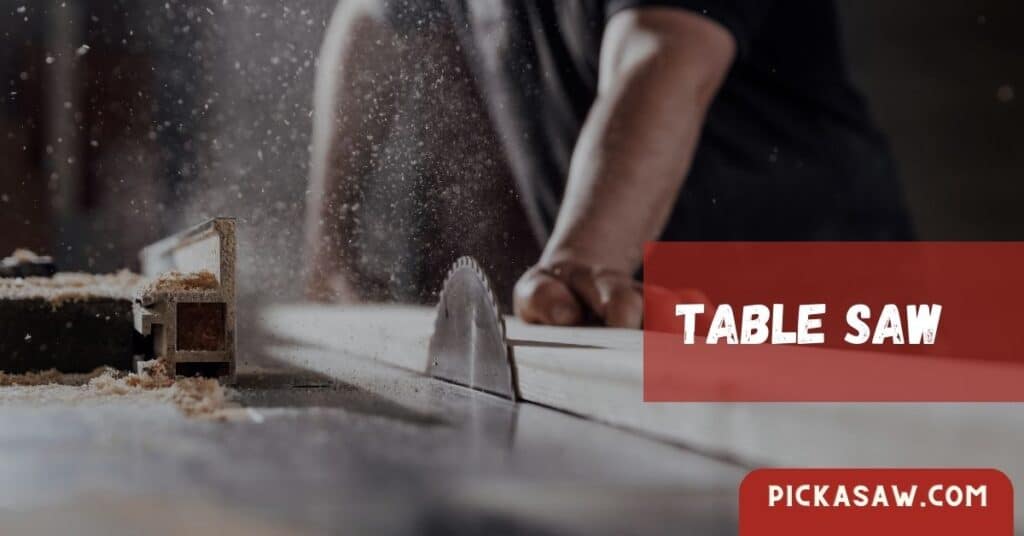
Similar to miter saws, table saws can also be classified as circular saws. These types of saws use a circular blade fixed onto a workbench or table. However, only a bit of the blade protrudes and is visible. And unlike other saws, you push the material you want to cut towards the blade. You can find table saws under $300 to more 1000+ in the market.
Features
- Large surface area for pushing materials toward the saw blade
- Fence for ensuring precise straight cuts
- Circular blade mounted under the workbench or table
Advantages Of Using Table Saws
- Generally, table saws are easy to use
- The large table means you can cut larger pieces of material
- These saws are ideal for making crosscuts and rip cuts
Disadvantages Of Using Table Saws
- Table saws are large and bulky and thus not portable
Table Saw Is Ideal For?
Table saws are used for making crosscuts and ripping through wood of different thicknesses.
11. Metal Circular Saws
While you can use virtually any kind of saw to cut through metal, if you have the right blade, some are designed specifically for cutting metal. These saws typically have smaller blades and are cut at a slower speed to reduce the chances of sparks generated from metal-on-metal contact.
Features
- Smaller blades
- Reduced blade speed
- Compact design
Advantages Of Using Metal Circular Saws
- These saws can cut through any type of metal
- There is no chance of sparks being produced from metal-on-metal contact
- Are safer for cutting metals
Disadvantages Of Using Metal Circular Saws
- They have smaller blades and are slower and thus take more time to cut through materials
Metal Circular Saw Is Ideal For?
- These types of saws are used primarily for cutting metals of all kinds
12. Cordwood Saws
Cordwood saws are perhaps the largest type of circular saws on the market. They are usually used for cutting large pieces of wood into smaller firewood. They have large blades and are usually mounted to a tractor
Features
- Large 20-36 diameter blades
- A hardened frame
- Larger and bulkier frame
Advantages Of Using Cordwood Saws
- Can cut large pieces or slabs of timber into smaller pieces
- It can be attached to a tractor for improved portability
- These saws can handle many different pieces of lumber
Disadvantages Of Using Cordwood Saws
- These saws are large and bulky and have largely been replaced by chainsaws
Cordwood Saw Is Ideal For?
These saws are used to cut large slabs of timber into smaller pieces.
13. Circular Carbide Saw
A Circular Carbide Saw is a cutting tool used in various industries to make precision cuts on different types of materials. It consists of a circular saw blade with carbide teeth that are designed to withstand high temperatures and provide excellent cutting performance. Here are the advantages, disadvantages, and common uses of Circular Carbide Saws:
Advantages of using Circular Carbide saw
- Circular Carbide Saws are known for their exceptional cutting efficiency. The carbide teeth are incredibly sharp and durable, allowing for fast and precise cutting of materials.
- These saws can be used to cut a wide range of materials, including wood, metal, plastic, and composites. They are suitable for both crosscuts and rip cuts, making them versatile for various applications.
- Carbide teeth have a significantly longer lifespan compared to traditional steel saw blades. They are more resistant to wear and can withstand higher temperatures, resulting in extended tool life and reduced maintenance costs.
- Circular Carbide Saws produce cleaner and smoother cuts compared to other types of saw blades. The sharp carbide teeth minimize splintering and reduce the need for additional finishing or sanding.
Disadvantages:
Circular Carbide Saws are generally more expensive than traditional steel saw blades. The use of carbide material and advanced manufacturing techniques contribute to their higher price point.
While carbide is highly durable, it is also more brittle compared to steel. This means that the saw blade may be more prone to chipping or breaking if it encounters unexpected impacts or excessive lateral forces during cutting.
Carbide saw blades require specific maintenance techniques. They should be stored properly to avoid damage, and sharpening or servicing typically requires professional expertise or specialized equipment.
Uses of carbide circular saw
- Woodworking: Circular Carbide Saws are extensively used in the woodworking industry for cutting various wood materials, including solid wood, plywood, particleboard, and MDF (medium-density fiberboard).
- Metalworking: These saws are also utilized in metal fabrication for cutting different types of metal, such as aluminum, steel, and copper. They can be used in industries like construction, automotive, and manufacturing.
- Plastics and Composites: Circular Carbide Saws are employed for cutting plastic materials, such as PVC, acrylic, and polycarbonate. They are also suitable for cutting composite materials like fiberglass or carbon fiber.
- Construction and Remodeling: Circular Carbide Saws find applications in construction and remodeling projects, including tasks like framing, cutting floorboards, trimming doors, and making accurate miter cuts.
- DIY and Hobbyist Projects: These saws are popular among DIY enthusiasts and hobbyists for their versatility and precision. They can be used for a wide range of projects, such as crafting, model-making, and home improvement tasks.
14. Biscuit Joiner Saws
A biscuit joiner, also known as a plate joiner, is a specialized power tool used in woodworking to create strong and precise joints. It is often used in carpentry and furniture making to join two pieces of wood together at a right angle.
Features of a Biscuit Joiner:
- Cutting Mechanism: A biscuit joiner uses a circular saw blade that rotates at high speed to cut a crescent-shaped slot, commonly known as a biscuit slot, in the edges of the two pieces of wood to be joined.
- Adjustable Depth and Angle: The depth and angle of the biscuit slot can be adjusted to suit different woodworking projects.
- Fence and Stops: Biscuit joiners typically have a fence and adjustable stops to help guide the tool and ensure accurate cuts.
- Dust Collection: Many modern biscuit joiners are equipped with a dust collection system to help keep the work area clean.
Advantages of a Biscuit Joiner:
- Strong and Stable Joints: Biscuit joinery provides strong and stable joints, especially when combined with glue. The biscuits help to align the pieces of wood and prevent them from shifting or rotating over time.
- Quick and Easy: Biscuit joinery is relatively quick and straightforward compared to other joinery methods, such as dovetail joints. It allows for the efficient assembly of wood pieces, saving time and effort.
- Disassemblability: Biscuit joints can be disassembled if needed, making repairs or modifications easier.
Disadvantages of a Biscuit Joiner:
- Limited Joint Strength: While biscuit joints are generally strong, they may not be as durable as other joint types, such as mortise and tenon or dovetail joints.
- Limited Applicability: Biscuit joinery is best suited for joining flat pieces of wood at right angles. It may not be suitable for all woodworking projects, particularly those with curved or irregular shapes.
- Cost and Maintenance: Biscuit joiners are specialized tools and can be relatively expensive. They require proper maintenance and periodic replacement of blades.
Uses of a Biscuit Joiner:
- Cabinet and furniture Making: Biscuit joinery is commonly used in the construction of cabinets, bookcases, tables, and other furniture pieces.
- Edge-to-Edge Joints: It is used to create strong and seamless edge-to-edge joints in tabletops, panels, and other large wooden surfaces.
- Mitre Joints: Biscuit joiners can be used to create reinforced mitre joints, where two angled pieces of wood meet at a corner.
Other Important Facts:
- Biscuits: Biscuits are oval-shaped wooden or plastic inserts that are inserted into the biscuit slots. They swell when they come into contact with glue, reinforcing the joint.
- Glue: Biscuit joinery relies on the use of woodworking glue to create strong bonds between the wood pieces.
- Safety Precautions: When using a biscuit joiner, it is important to wear safety goggles, hearing protection, and follow the manufacturer’s instructions for safe operation.
15. Cold Circular Saw:
A cold circular saw, also known as a metal-cutting circular saw or cold saw, is a power tool used to cut various types of metal materials. Unlike traditional abrasive saws, cold saws utilize a toothed circular blade that cuts through the metal by removing a small amount of material with each pass. Here are the features, advantages, disadvantages, uses, and other important facts about cold circular saws:
Features:
- Circular Blade: Cold circular saws feature a circular blade with numerous teeth designed specifically for cutting metal.
- Cutting Capacity: They can cut through a wide range of metal materials, including steel, aluminum, copper, and more.
- Precision Cutting: Cold saws offer precise and accurate cuts, allowing for clean and smooth edges.
- Cooling Mechanism: These saws typically have a built-in cooling mechanism that uses a coolant or lubricant to keep the blade and workpiece cool during cutting.
- Adjustable Angles: Many cold circular saws come with adjustable angles, allowing for bevel cuts and angled cuts.
Advantages:
- High-Quality Cuts: Cold saws produce clean, burr-free cuts with minimal heat distortion, resulting in high-quality finished pieces.
- Efficiency: They are capable of cutting through metal quickly, making them ideal for projects that require speedy completion.
- Versatility: Cold circular saws can handle a variety of metal materials and thicknesses, making them suitable for a wide range of applications.
- Accuracy: These saws provide precise cuts, which is essential for tasks that demand accuracy, such as metal fabrication or construction.
- Reduced Sparks and Heat: Compared to abrasive saws, cold saws generate significantly fewer sparks and produce less heat during the cutting process.
Disadvantages:
- Limited Cutting Depth: Cold circular saws have a maximum cutting depth, so they may not be suitable for cutting extremely thick metal pieces.
- Cost: Cold saws tend to be more expensive than traditional abrasive saws due to their specialized design and features.
- Maintenance: The cooling mechanism of cold saws requires regular maintenance, including cleaning and refilling the coolant or lubricant.
Uses:
- Metal Fabrication: Cold circular saws are commonly used in metal fabrication shops for cutting metal bars, tubes, and profiles.
- Construction: They are also used in construction projects to cut metal pipes, beams, and other metal components.
- Automotive Industry: Cold saws find applications in the automotive industry for cutting metal parts, frames, and exhaust systems.
- Plumbing and HVAC: These saws are utilized in plumbing and HVAC installations for cutting metal pipes and ductwork.
- DIY Projects: Cold circular saws are suitable for DIY enthusiasts working on metal-based projects, such as home renovations or metal artwork.
